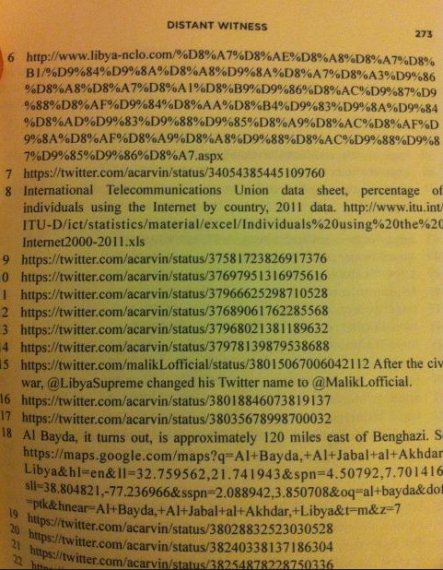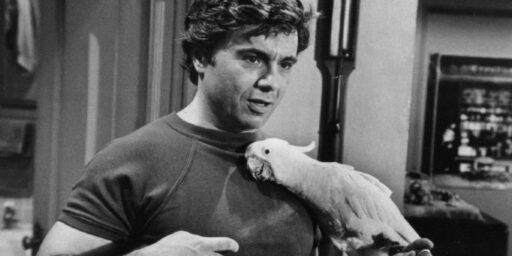Footnoting Social Media
Blake Hounshell finds the footnotes in Andy Carvin's latest book somewhat amusing:
Blake Hounshell finds the footnotes in Andy Carvin’s latest book somewhat amusing:
He’s right, on a number of levels. A series of URL’s without other information are almost useless for a paper book (imagine trying to type footnote 6’s URL into a browser manually). Most of the cites, on this page at least, are just his own tweets. And, as a bonus, Twitter doesn’t archive content all that long, so Carvin’s tweets from a year ago are likely gone into the ether, so there will be zero value to the citations.
I don’t know what citation guide, if any, Carvin is using. I don’t know of any that use just URLs; most at least include identifying information about the source. So, for example, footnote 6 would usually begin with The National Conference of the Libyan Opposition, the title of the page in question, any other information about the page that would help the reader understand its value, and then the URL.
As to the ephemeral nature of tweets, I’m not sure what protocol future researchers will use to solve the problem. In this particular case, the whole book is about social media and the Arab Spring. So it’s not as if it’s just one or two tweets are cited; it’s the basis for much of the research. So, it’d definitely be a service to the readers to preserve the tweets being cited in some fashion. My instinct would be to archive all of them in some way–screencaptures, maybe, if there’s not something more sophisticated available–on a site that I could ensure would be available to those using the book, either a personal website on a domain related to the book (distantwitness.com?), the author, or the author’s institution.







This is actually a very interesting question.
There still doesn’t seem to be any standard for citing to online sources and, worse yet, there’s nothing that can be done if the content in question happens to disappear from the internet for one reason or another.
As I noted when I responded to this on Twitter, I would at least hope that an e-book version of this work would have hyperlinks to the sources referenced. Even Wikipedia does that, although they too face the issue of dead links
It’s possible the Wayback Machine has preserved much of this. I don’t know if they do Twitter, nor do I care.
@Doug Mataconis: I’m not familiar with which style guides are pervasive among what fields since as an undergrad, we mainly used MLA and APA styles in my classes, but the the Modern Language Assocation does provide on their website guidelines on how to cite a Tweet, which includes quotation of the entire Tweet. APA stylebook also includes guidelines for citing online sources, but not Tweets specifically.
Let’s use Storify and miniature QR codes.
There’s also interactive newsprint: http://interactivenewsprint.org/
And some interesting research in the area as well: http://www8.org/w8-papers/4b-links/hyperlinks/hyperlinks.html
Actually, this isn’t really footnotes in the academic sense. This is an archive of all the tweets contained in my book. If you look at the chapter that refers to this page, you’ll see the full text of each tweet. So there’s no need for screen captures, because each tweet is contained in full in the book. For reference, I’ve taken a screen shot of the page in question, so you can see for yourself:
http://twitpic.com/bk9xgk
It’s incorrect to assume that each URL won’t work because Twitter doesn’t deep link. That’s actually not true, as long as you know the tweet’s original ID number. Every single one of the 1,500+ tweets referenced in the book have fully functioning URLs, because Twitter gave me the ID codes associated with all of them. So in truth, none of these URLs is ephemeral. They all work as originally intended, despite the fact that you can’t find most of them through google searches.
Some people have suggested I should’ve used short URLs, which I would have loved to have done. Short urls might have made the links prettier, but short url companies come and go over time. Try looking up links in tweets that used deck.ly, urltea.com, etc. They’re all dead links now. By displaying the full tweet with the correct twitter ID at the end, it’s the only way to preserve the last remaining permalink to tweets that would otherwise have been lost to history. The same thing with QR codes. I don’t know if QR codes will exist 10 years from now, so I didn’t want to include a potentially obsolete technology in the book.
Lastly, despite the fact these tweets look like mine, most of them aren’t written by me. They’re native retweets of hundreds of people throughout my book. For whatever reason, this is how Twitter preserves the permalinks.
Oh, one other thing. That insanely long tweet at the top of the page doesn’t look like that in the final version of the book. Blake just happened to flip to the one page in the back of the book that has a long URL that was later truncated for the publication copy.
@Andy Carvin: Thanks for the update and information. However, it’s not clear to me that you addressed one of Joyner’s points, that “Twitter doesn’t archive content all that long”. Is that not true for the ID’d links?